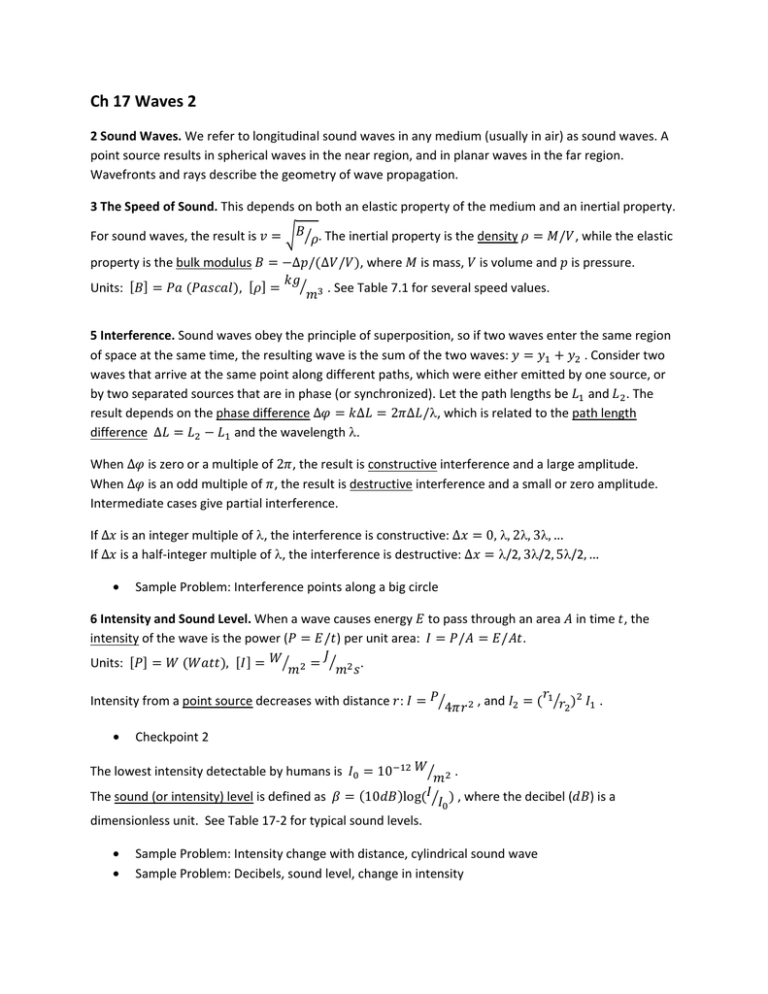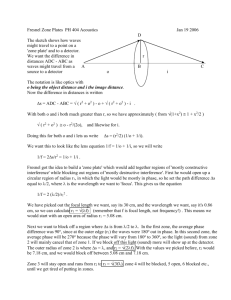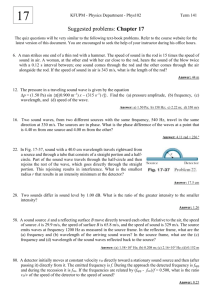Ch 17 Waves 2
advertisement

Ch 17 Waves 2 2 Sound Waves. We refer to longitudinal sound waves in any medium (usually in air) as sound waves. A point source results in spherical waves in the near region, and in planar waves in the far region. Wavefronts and rays describe the geometry of wave propagation. 3 The Speed of Sound. This depends on both an elastic property of the medium and an inertial property. For sound waves, the result is = property is the bulk modulus = −∆ /(∆ / ), where Units: [ ] = ( . The inertial property is the density ), [ ] = is mass, = / , while the elastic is volume and is pressure. . See Table 7.1 for several speed values. 5 Interference. Sound waves obey the principle of superposition, so if two waves enter the same region of space at the same time, the resulting wave is the sum of the two waves: = + . Consider two waves that arrive at the same point along different paths, which were either emitted by one source, or by two separated sources that are in phase (or synchronized). Let the path lengths be and . The result depends on the phase difference ∆ = ∆ = 2 ∆ /, which is related to the path length difference ∆ = − and the wavelength . When ∆ is zero or a multiple of 2 , the result is constructive interference and a large amplitude. When ∆ is an odd multiple of , the result is destructive interference and a small or zero amplitude. Intermediate cases give partial interference. If ∆ is an integer multiple of , the interference is constructive: ∆ = 0,, 2, 3, … If ∆ is a half-integer multiple of , the interference is destructive: ∆ = /2, 3/2, 5/2, … • Sample Problem: Interference points along a big circle 6 Intensity and Sound Level. When a wave causes energy to pass through an area intensity of the wave is the power ( = / ) per unit area: = / = / . Units: [ ] = ( ), [ ] = = . Intensity from a point source decreases with distance : = • , and 4 =( ) . Checkpoint 2 The lowest intensity detectable by humans is The sound (or intensity) level is defined as = 10 = (10 . )log( ) , where the decibel ( dimensionless unit. See Table 17-2 for typical sound levels. • • in time , the Sample Problem: Intensity change with distance, cylindrical sound wave Sample Problem: Decibels, sound level, change in intensity ) is a 7 Sources of Musical Sound. Resonant sound waves can be established in an air-filled pipe, just as the standing waves on a string. We consider two important cases: a) both ends of the pipe are open, or b) one end is open and the other end closed. Again we apply the terms resonant frequency, fundamental and harmonics. The one with the lowest frequency (longest wavelength ) is the fundamental mode or first harmonic. Subsequent standing wave patterns, with increasing frequency (decreasing wavelength) are the second harmonic ( , ), third harmonic ( , ), and so on… a) Sound waves in a double-open pipe: = 2 , b) Sound waves in a single-open pipe: = 4 , • • = = ; = ; = , , = = , , = 1, 2, 3, … = 1, 3, 5, … Checkpoint 3 Sample Problem: Sound resonance in double-open pipe and single-open pipe 8 Beats. When two sounds with slightly different frequencies ( = /2 and = /2 ) interfere =| − |= /2 . over time, they give rise to an apparent sound with the beat frequency: The actual waveform (displacement or pressure change) takes the form ( ) = [2 cos ’ ] cos , where = ( + )/2 and ′ = ( − )/2. • Sample Problem: Beat frequencies and penguins finding one another 9 The Doppler Effect. When either the source or the observer of a given sound is moving, the sound undergoes a Doppler shift. The sound is emitted by the source (S) with frequency and observed by the detector (or observer) (D) with frequency . The speed of sound in air is = 343 / . = ± ± : speed of the source relative to the air. : speed of the detector relative to the air. The choice of signs (each±becoming + or −) is determined by the direction of the motion of the source and detector. If the source (detector) moves toward the detector (source), that increases the observed frequency; if the source (detector) moves away from the detector (source), that decreases the observed frequency. If the detector is moving, but the source is stationary, this becomes ′ = ( ± ) , where the sign is positive if moving toward the source, negative if moving away from the source. If the source is moving, but the detector is stationary, this becomes ′ = /( ± ) , where the sign is negative if moving toward the detector, positive if moving away from the detector . • • Checkpoint 4 Sample Problem: Double Doppler shift in the echoes used by bats ----------------Material below is not covered in this course----------------------------------------------------4 Traveling Sound Waves 10 Supersonic Speeds, Shock Waves




